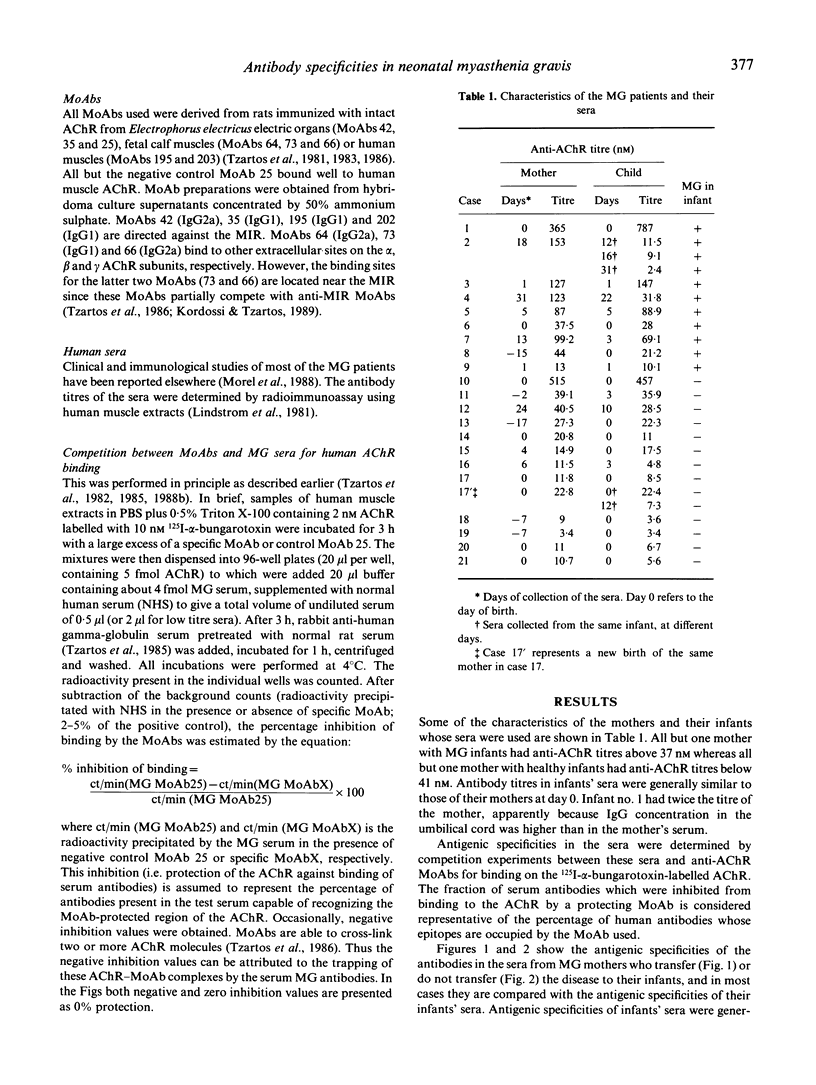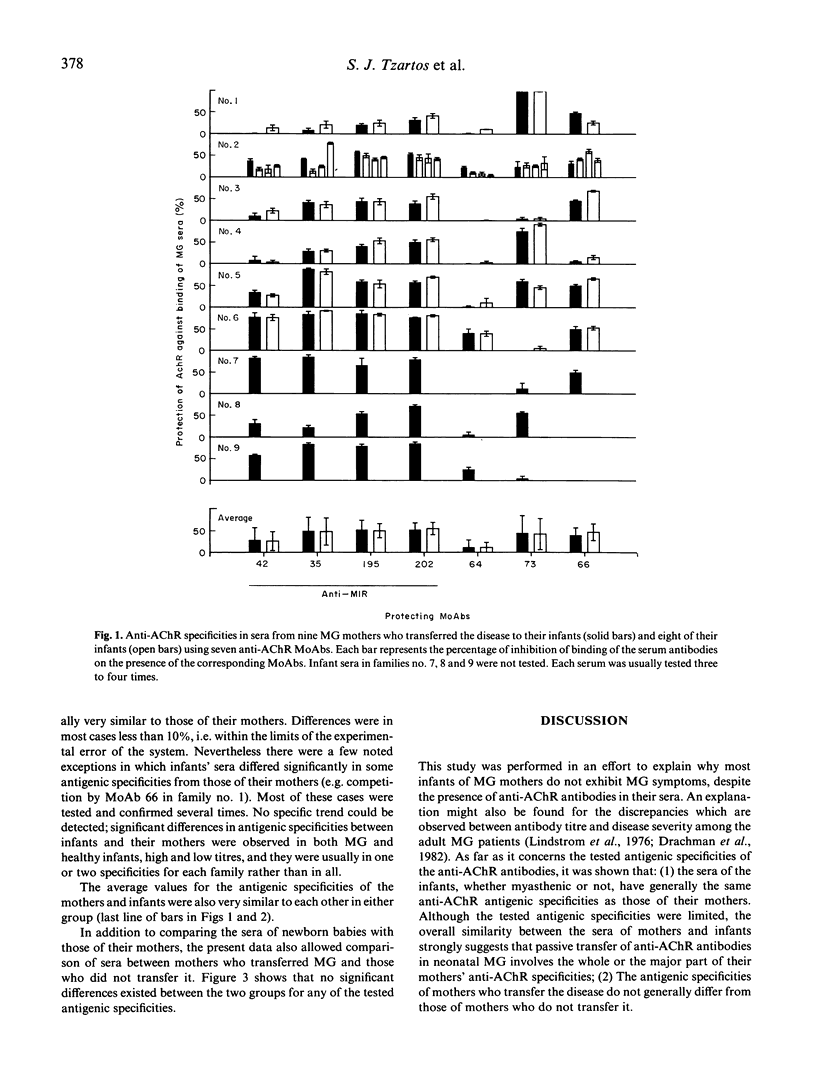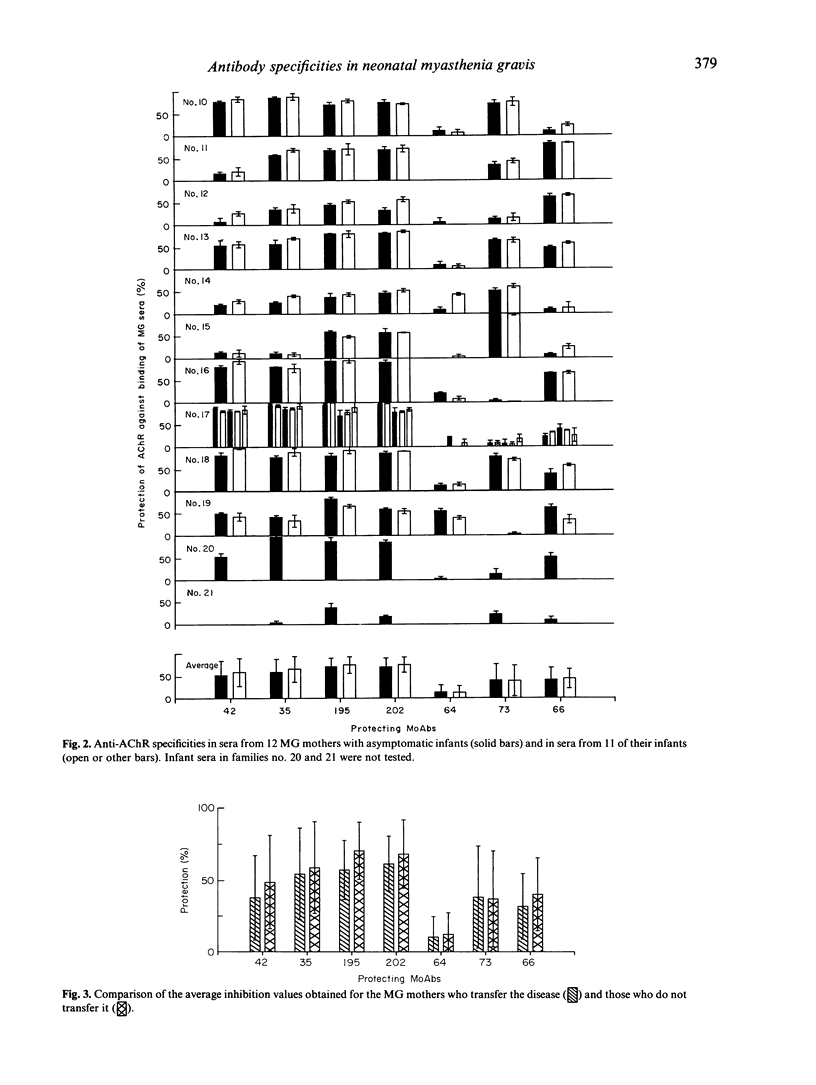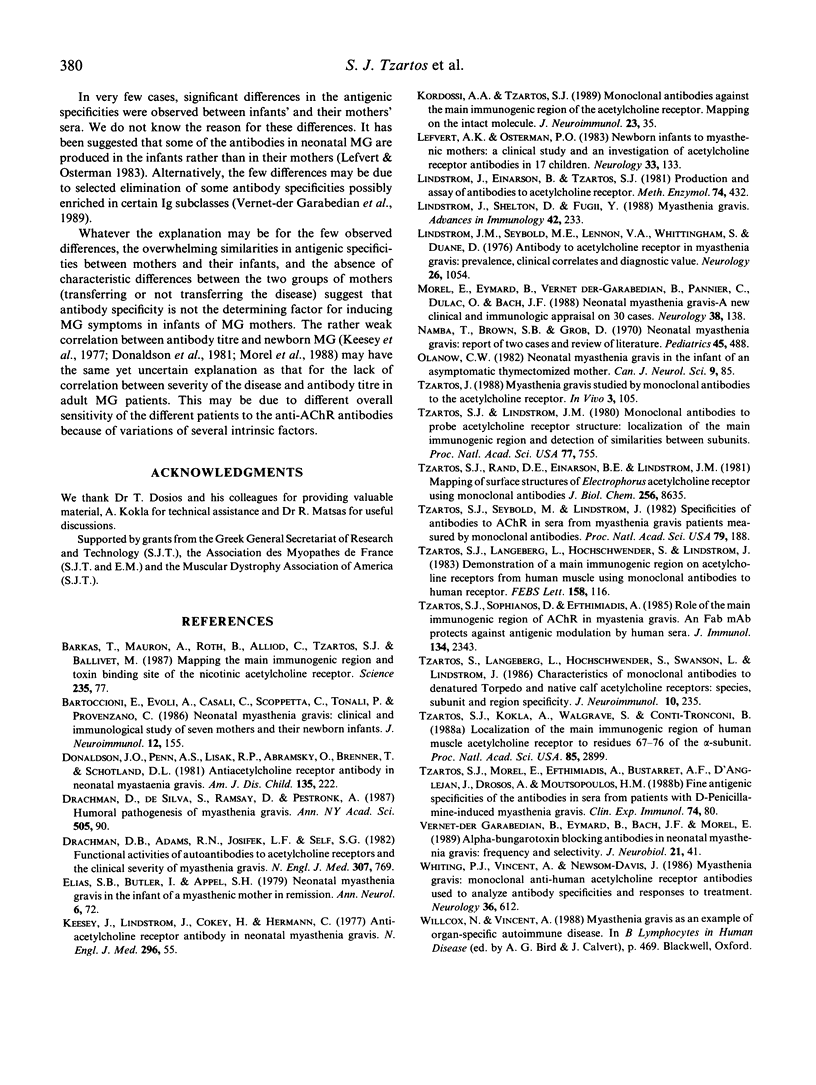Abstract
Transient neonatal myasthenia gravis (MG) is a human model of passively transferred MG. In an effort to understand the characteristics of the most pathogenic antibodies in MG, we studied the fine antigenic specificities of anti-AChR antibodies in sera from 21 MG mothers (nine of which had transiently transferred the disease) and 17 of their infants. Although in a few cases significant differences in antibody specificities were observed between mothers and infants, whether myasthenic or not, generally the antigenic specificities of the antibodies in sera from infants were very similar to those of their mothers. Furthermore, no characteristic differences were detected between the antibody repertoires of mothers who transferred the disease and those who did not.
Full text
PDF




Selected References
These references are in PubMed. This may not be the complete list of references from this article.
- Barkas T., Mauron A., Roth B., Alliod C., Tzartos S. J., Ballivet M. Mapping the main immunogenic region and toxin-binding site of the nicotinic acetylcholine receptor. Science. 1987 Jan 2;235(4784):77–80. doi: 10.1126/science.2432658. [DOI] [PubMed] [Google Scholar]
- Bartoccioni E., Evoli A., Casali C., Scoppetta C., Tonali P., Provenzano C. Neonatal myasthenia gravis: clinical and immunological study of seven mothers and their newborn infants. J Neuroimmunol. 1986 Aug;12(2):155–161. doi: 10.1016/0165-5728(86)90028-7. [DOI] [PubMed] [Google Scholar]
- Donaldson J. O., Penn A. S., Lisak R. P., Abramsky O., Brenner T., Schotland D. L. Antiacetylcholine receptor antibody in neonatal myasthenia gravis. Am J Dis Child. 1981 Mar;135(3):222–226. doi: 10.1001/archpedi.1981.02130270014006. [DOI] [PubMed] [Google Scholar]
- Drachman D. B., Adams R. N., Josifek L. F., Self S. G. Functional activities of autoantibodies to acetylcholine receptors and the clinical severity of myasthenia gravis. N Engl J Med. 1982 Sep 23;307(13):769–775. doi: 10.1056/NEJM198209233071301. [DOI] [PubMed] [Google Scholar]
- Drachman D. B., de Silva S., Ramsay D., Pestronk A. Humoral pathogenesis of myasthenia gravis. Ann N Y Acad Sci. 1987;505:90–105. doi: 10.1111/j.1749-6632.1987.tb51285.x. [DOI] [PubMed] [Google Scholar]
- Elias S. B., Butler I., Appel S. H. Neonatal myasthenia gravis in the infant of a myasthenic mother in remission. Ann Neurol. 1979 Jul;6(1):72–75. doi: 10.1002/ana.410060119. [DOI] [PubMed] [Google Scholar]
- Keesey J., Lindstrom J., Cokely H. Anti-acetylcholine receptor antibody in neonatal myasthenia gravis. N Engl J Med. 1977 Jan 6;296(1):55–55. doi: 10.1056/NEJM197701062960125. [DOI] [PubMed] [Google Scholar]
- Kordossi A. A., Tzartos S. J. Monoclonal antibodies against the main immunogenic region of the acetylcholine receptor. Mapping on the intact molecule. J Neuroimmunol. 1989 Jun;23(1):35–40. doi: 10.1016/0165-5728(89)90070-2. [DOI] [PubMed] [Google Scholar]
- Lefvert A. K., Osterman P. O. Newborn infants to myasthenic mothers: a clinical study and an investigation of acetylcholine receptor antibodies in 17 children. Neurology. 1983 Feb;33(2):133–138. doi: 10.1212/wnl.33.2.133. [DOI] [PubMed] [Google Scholar]
- Lindstrom J. M., Seybold M. E., Lennon V. A., Whittingham S., Duane D. D. Antibody to acetylcholine receptor in myasthenia gravis. Prevalence, clinical correlates, and diagnostic value. Neurology. 1976 Nov;26(11):1054–1059. doi: 10.1212/wnl.26.11.1054. [DOI] [PubMed] [Google Scholar]
- Lindstrom J., Einarson B., Tzartos S. Production and assay of antibodies to acetylcholine receptors. Methods Enzymol. 1981;74(Pt 100):432–460. doi: 10.1016/0076-6879(81)74031-x. [DOI] [PubMed] [Google Scholar]
- Lindstrom J., Shelton D., Fujii Y. Myasthenia gravis. Adv Immunol. 1988;42:233–284. doi: 10.1016/s0065-2776(08)60847-0. [DOI] [PubMed] [Google Scholar]
- Morel E., Eymard B., Vernet-der Garabedian B., Pannier C., Dulac O., Bach J. F. Neonatal myasthenia gravis: a new clinical and immunologic appraisal on 30 cases. Neurology. 1988 Jan;38(1):138–142. doi: 10.1212/wnl.38.1.138. [DOI] [PubMed] [Google Scholar]
- Namba T., Brown S. B., Grob D. Neonatal myasthenia gravis: report of two cases and review of the literature. Pediatrics. 1970 Mar;45(3):488–504. [PubMed] [Google Scholar]
- Olanow C. W., Lane R. J., Hull K. L., Jr, Roses A. D. Neonatal myasthenia gravis in the infant of an asymptomatic thymectomized mother. Can J Neurol Sci. 1982 May;9(2):85–87. doi: 10.1017/s0317167100043730. [DOI] [PubMed] [Google Scholar]
- Tzartos S. J., Kokla A., Walgrave S. L., Conti-Tronconi B. M. Localization of the main immunogenic region of human muscle acetylcholine receptor to residues 67-76 of the alpha subunit. Proc Natl Acad Sci U S A. 1988 May;85(9):2899–2903. doi: 10.1073/pnas.85.9.2899. [DOI] [PMC free article] [PubMed] [Google Scholar]
- Tzartos S. J., Lindstrom J. M. Monoclonal antibodies used to probe acetylcholine receptor structure: localization of the main immunogenic region and detection of similarities between subunits. Proc Natl Acad Sci U S A. 1980 Feb;77(2):755–759. doi: 10.1073/pnas.77.2.755. [DOI] [PMC free article] [PubMed] [Google Scholar]
- Tzartos S. J., Morel E., Efthimiadis A., Bustarret A. F., D'Anglejan J., Drosos A. A., Moutsopoulos H. A. Fine antigenic specificities of antibodies in sera from patients with D-penicillamine-induced myasthenia gravis. Clin Exp Immunol. 1988 Oct;74(1):80–86. [PMC free article] [PubMed] [Google Scholar]
- Tzartos S. J. Myasthenia gravis studied by monoclonal antibodies to the acetylcholine receptor. In Vivo. 1988 Jan-Feb;2(1):105–110. [PubMed] [Google Scholar]
- Tzartos S. J., Rand D. E., Einarson B. L., Lindstrom J. M. Mapping of surface structures of electrophorus acetylcholine receptor using monoclonal antibodies. J Biol Chem. 1981 Aug 25;256(16):8635–8645. [PubMed] [Google Scholar]
- Tzartos S. J., Seybold M. E., Lindstrom J. M. Specificities of antibodies to acetylcholine receptors in sera from myasthenia gravis patients measured by monoclonal antibodies. Proc Natl Acad Sci U S A. 1982 Jan;79(1):188–192. doi: 10.1073/pnas.79.1.188. [DOI] [PMC free article] [PubMed] [Google Scholar]
- Tzartos S. J., Sophianos D., Efthimiadis A. Role of the main immunogenic region of acetylcholine receptor in myasthenia gravis. An Fab monoclonal antibody protects against antigenic modulation by human sera. J Immunol. 1985 Apr;134(4):2343–2349. [PubMed] [Google Scholar]
- Tzartos S., Langeberg L., Hochschwender S., Lindstrom J. Demonstration of a main immunogenic region on acetylcholine receptors from human muscle using monoclonal antibodies to human receptor. FEBS Lett. 1983 Jul 11;158(1):116–118. doi: 10.1016/0014-5793(83)80688-7. [DOI] [PubMed] [Google Scholar]
- Tzartos S., Langeberg L., Hochschwender S., Swanson L. W., Lindstrom J. Characteristics of monoclonal antibodies to denatured Torpedo and to native calf acetylcholine receptors: species, subunit and region specificity. J Neuroimmunol. 1986 Jan;10(3):235–253. doi: 10.1016/0165-5728(86)90105-0. [DOI] [PubMed] [Google Scholar]
- Whiting P. J., Vincent A., Newsom-Davis J. Myasthenia gravis: monoclonal antihuman acetylcholine receptor antibodies used to analyze antibody specificities and responses to treatment. Neurology. 1986 May;36(5):612–617. doi: 10.1212/wnl.36.5.612. [DOI] [PubMed] [Google Scholar]


